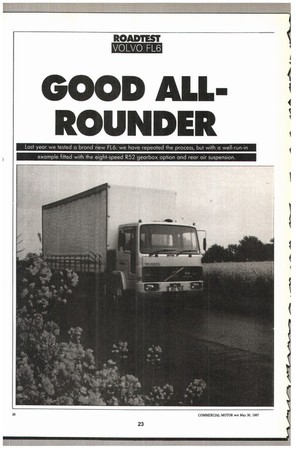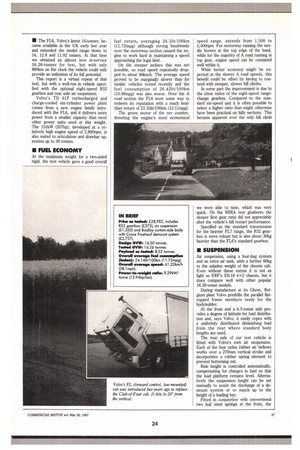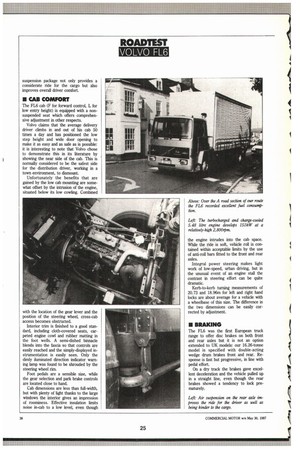GOOD ALL ROUNDER
Page 139

Page 140

Page 141

Page 142

If you've noticed an error in this article please click here to report it so we can fix it.
Last year we tested a brand riew FL6: we have repeated the process, but with a well-run-in example fitted with the eight-speed R52 gearbox option and rear air suspension.
• The FL6, Volvo's latest 16-tonner, became available in the UK early last year and extended the model range down to 14, 12.8 and 11.92 tonnes. At that time we obtained an almost new in-service 16.26-tormer for test, but with only 800km on the clock the vehicle could only provide an indication of its full potential.
This report is a virtual repeat of that test, but with a well-mm in vehicle specified with the optional eight-speed R52 gearbox and rear axle air suspension.
Volvo's TD 61F turbocharged and charge-cooled six-cylinder power plant comes from a new engine family introduced with the FL6, and it delivers more power from a smaller capacity than most other power units used at this weight. The 151kW (207hp), developed at a relatively high engine speed of 2,800rpm, is also suited to articulation and drawbar operation up to 28 tonnes.
• FUEL ECONOMY
At the maximum weight for a two-aided rigid, the test vehicle gave a good overall fuel return, averaging 24.1lit/100km (11.72mpg) although strong headwinds over the motorway section caused the engine to work hard in maintaining a speed approaching the legal limit.
On the steeper inclines this was not possible, so road speed repeatedly dropped to about 88km/h. The average speed proved to be marginally slower than for similar vehicles tested recently and the fuel consumption of 26.421it/100km (10.69mpg) was also worse. Over the A road section the FL6 went some way to redeem its reputation with a much healthier return of 23.321it/100Iun (12.11mpg).
The green sector of the rev counter, denoting the engine's most economical speed range, extends from 1,500 to 2,400rpm. For motorway running the needle hovers at the top edge of the band, while for the majority of A road running in top gear, engine speed can be contained well within it.
While better economy might be expected at the slower A road speeds, this benefit could be offset by having to contend with steeper, slower hill climbs.
In some part the improvement is due to the close ratios of the eight-speed rangechange gearbox. Compared to the standard six-speed unit it is often possible to select a higher ratio than might otherwise have been practical on hilly sections. This became apparent over the only hill climb we were able to time, which was very quick. On the MIRA test gradients the deeper first gear ratio did not appreciably alter the vehicle's hill restart performance.
Specified as the standard transmission for the heavier FL7 range, the R52 gearbox is more robust but is also about 301cg heavier than the FL6's standard gearbox.
• SUSPENSION
Air suspension, using a four-bag system and an extra air tank, adds a further 60kg to the unladen weight of the chassis cab. Even without these extras it is not as light as ERF's E6-18 4x2 chassis, but it does compare well with other popular 16.26-tonne models.
During manufacture at its Ghent, Belgium plant Volvo predrills the parallel flattopped frame members ready for the bodybuilder.
At the front end a 6.5-tonne axle provides a degree of latitude for load distribution and, says Volvo, it easily copes with a uniformly distributed diminishing load from the rear where standard body lengths are used.
The rear axle of our test vehicle is fitted with Volvo's own air suspension. Each of the four nylon rubber air bellows works over a 270mm vertical stroke and incorporates a rubber spring element to prevent bottoming out.
Ride height is controlled automatically, compensating for changes in load so that the load platform remains level. Alternatively the suspension height can be set manually to assist the discharge of a demount system or to match up to the height of a loading bay.
Fitted in conjunction with conventional two leaf steel springs at the front, the suspension package not only provides a considerate ride for the cargo but also improves overall driver comfort.
• CAB COMFORT
The FL6 cab (F for forward control, L for low entry height) is equipped with a nonsuspended seat which offers comprehensive adjustment in other respects.
Volvo claims that the average delivery driver climbs in and out of his cab 50 times a day and has positioned the low step height and wide door opening to make it as easy and as safe as is possible: it is interesting to note that Volvo chose to demonstrate this in its literature by showing the near side of the cab. This is normally considered to be the safest side for the distribution driver, working in a town environment, to dismount.
Unfortunately the benefits that are gained by the low cab mounting are somewhat offset by the intrusion of the engine, situated below its low cowling. Combined with the location of the gear lever and the position of the steering wheel, cross-cab access becomes obstructed.
Interior trim is finished to a good standard, including cloth-covered seats, carpeted engine cowl and rubber matting in the foot wells. A semi-dished binnacle blends into the fascia so that controls are easily reached and the simply-displayed instrumentation is easily seen. Only the dimly iluminated direction indicator warning lamp was found to be shrouded by the steering wheel rim.
Foot pedals are a sensible size, while the gear selection and park brake controls are located close to hand.
Cab dimensions are less than full-width, but with plenty of light thanks to the large windows the interior gives an impression of roominess. Effective insulation limits noise in-cab to a low level, even though the engine intrudes into the cab space. While the ride is soft, vehicle roll is contained within acceptable limits by the use of anti-roll bars fitted to the front and rear aides.
Integral power steering makes light work of low-speed, urban driving, but in the unusual event of an engine stall the contrast in steering effort can be quite dramatic.
Kerb-to-kerb turning measurements of 20.73 and 18.96m for left and right hand locks are about average for a vehicle with a wheelbase of this size. The difference in the two dimensions can be easily corrected by adjustment.
• BRAKING
The FL6 was the first European truck range to offer disc brakes on both front and rear axles but it is not an option extended to UK models: our 16.26-tonne model is specified with double-acting wedge drum brakes front and rear. Response is fast but progressive, in line with pedal effort.
On a dry track the brakes gave excellent deceleration and the vehicle pulled up in a straight line, even though the rear brakes showed a tendency to lock prematurely. The spring park brakes held convincingly on a 25% (1-in-4) gradient and only just failed to do so on the 33% (1-in-3) test hill.
Alone among Volvos the FL6 uses a butterfly-type exhaust brake which we believe to be a marked improvement over the pressure regulator used on other power units
• TRANSMISSION
Under normal operation there is no need to use all eight gears. When starting off on the flat, second gear is quite adequate followed by fourth and then sequentially up to eighth. Without resorting to maximum revs acceleration remains lively as torque falls off gradually over the 600rpm above the maximum output at 1,600rpm.
The fully-synchronised gearbox allows fast, sure selection of every ratio without any need to double declutch. Changes between high and low ranges are activated just as swiftly using a toggle switch mounted in the gear lever head.
The shallow torque curve extending over a wide engine speed range gives the vehicle a great degree of flexibility.
• SUMMARY
The FL6 provides all of the attributes expected of a modern 16.26-tonner. It has the power for operation up to 28-tonnes GTW and is light enough to allow a good payload as a solo rifijcl.
Fuel consumptions often vary according to prevailing conditions which, to some degree, accounts for the poor motorway returns. In an urban distribution environment, however, our test vehicle has stolen a march on others recently tested at the same weight.
Air suspension adds to the ride comfort and has other advantages, while roll is not excessive.
Drum brakes all round give safe braking, and for once we have found a Volvo exhaust brake that offers a detectable retardation.
At a basic price of 223,500 the Volvo FL6 16.26-tonne model is very competitive with other makes of vehicle in the market place and with options of an eightspeed synchromesh gearbox and a factory-fitted rear axle air suspension, its ecification is superior to most.
by Bill Brock




























































































































































































